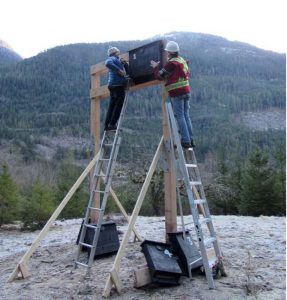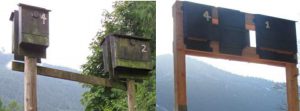Conserving bats and their habitat in the Clowhom Watershed
This project will help conserve bats and their habitat in the Clowhom River Watershed by protecting and repairing two bat maternity roosts, each housing more than 1,000 bats; identifying and protecting additional bat roosts; undertaking white-nose syndrome (WNS) surveillance; and installing and monitoring bat houses to determine ideal design, placement, and temperature. This project will help build healthy and resilient populations of little brown myotis, yuma myotis, and migratory bats, prior to the expected arrival of WNS in BC.
Update: 45 bat houses installed; repairs made to maternity roost
Bats in the Clowhom River Watershed will benefit from 45 newly installed bat houses. A local maternity box cluster—used by more than 600 bats—has been repaired and upgraded. This work will help ensure the survival of bats and their habitat in the watershed and surrounding communities.
The Sunshine Coast Wildlife Project—a group of biologists working with the community to conserve, restore, and enhance wildlife habitat—is leading this project. They have also documented 74 new bat roosts, including a maternity colony with over 400 bats, and are working with landowners to protect these sites. Emergence counts—when bats leave a site at dusk—have been conducted at more than 100 sites, and community outreach has been delivered through school programs and seven bat house-building workshops.
- Bats in the Clowhom Lake cabin. Photo: Sunshine Coast Wildlife Project
- Repairing the maternity box cluster. Photo: Sunshine Coast Wildlife Project
- Before and after repairs to the maternity box cluster. Photo: Sunshine Coast Wildlife Project
Final report: executive summary
Bats are one of the most threatened wildlife groups, impacted by multiple factors including habitat loss and degradation, declines in insect populations, mortality at wind turbines, chemical pollution, and accidental and deliberate human disturbance. An even larger threat looms with the specter of White-nose Syndrome (WNS), a deadly introduced fungal disease which kills up to 95% of bats in affected colonies and is now spreading within Washington State. The purpose of this project is to help ensure the survival of bats and their habitat in Clowhom watershed and surrounding communities on the Lower Sunshine Coast.
This report summarizes work during the first year of a three-year project. Our objectives in 2019-2020 were: (1) To improve and increase bat roosting habitat; (2) To increase the number of protected maternity roosts and hibernacula; (3) To undertake White-nose Syndrome surveillance; (4) To provide scientific information to guide conservation of bats; and (5) To undertake public outreach and engagement.
Click the provincial database link below to read the full final report for this project.





